The Penn State Extension Master Gardeners of Cumberland County conducted trials of annual plants donated and purchased from area garden centers in 2022 to increase public awareness of exceptional plants that perform well in our area.
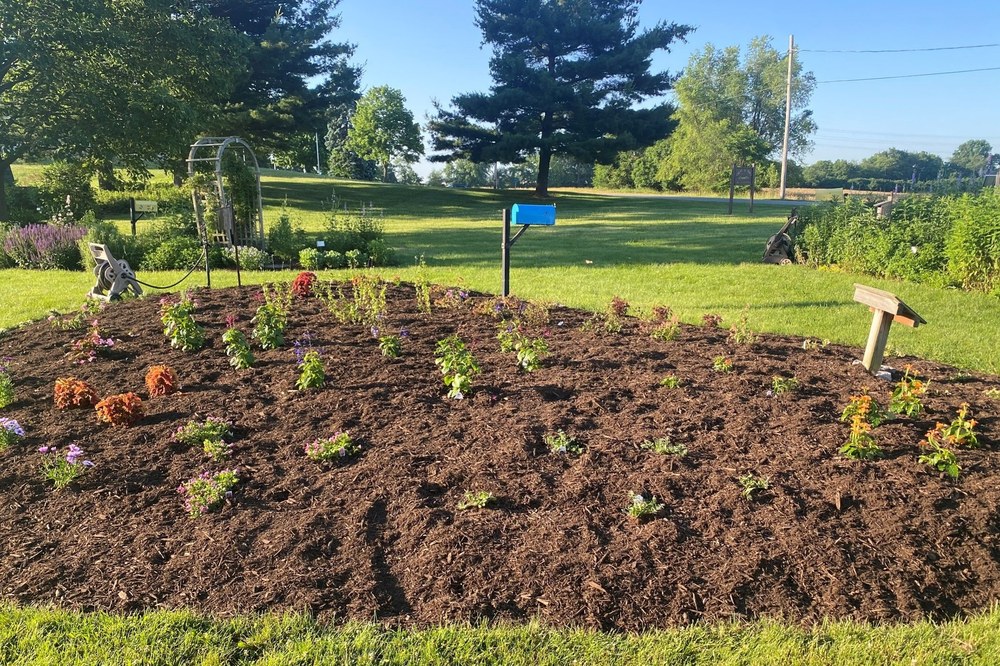
2022 Trial Garden, Carlisle, PA
Plant Sources
Each year one of the six beds at the Trial and Idea Garden is planted with new and exciting plants to test their performance in central Pennsylvania gardens. New cultivars and recently released cultivars for Northeast gardens are sought. In late winter, committee members contribute suggestions for plants to 'trial' in the Trial Garden. The ideas come from news articles, catalogs, and growers' reports. Close to the average last frost date in our area, our wish list is sent to Ashcombe Farm and Greenhouse who generously donates many of the plants for the Trial Garden. Ashcombe always provides an exciting array of cultivars. Additional plants from local garden centers supplement the donated plants.
Twenty to twenty-five different cultivars are planted in the Trial Garden each year generally in groups of three to five. The taller cultivars are placed in the center of the garden with shorter plants placed along the perimeters. In 2022, twenty-five cultivars were planted with several sets in the same genus or genus and species for a little added visual experimentation.
The Sign Garden and the Pollinator Garden also receive some colorful annuals to complement the perennials in those beds. The annuals in the Sign Garden are provided by Allaire Health Services, the organization that owns the property where the Trial and Idea Garden is located. Allaire also supplies mulch for all the garden beds.
Methods
The Trial and Idea Garden is tended on a weekly basis by our committee members. Early in the season, special attention is directed at watering our newly planted annuals. Regular and necessary garden maintenance is performed throughout the growing season with additional spring and fall workdays. No fertilizer other than compost from our three-bin composting system is used.
The plants in the Trial Garden are evaluated every other week by members of the committee. Evaluations include uniformity, foliage, flower, and overall appearance on a scale of 1 (low) to 4 (high) based on the plant's expected behavior. Animal damage from the four-legged variety is not considered in the evaluation process but insect and disease damage are. In 2022, evaluations began three weeks after planting and ended in mid-September when many of the plants showed significant decline. Flower count and size measurements were taken from the best performing plant in the group in early August.
Plants grown for foliage are not evaluated in the flower category. Therefore, the score for each group of plants has been translated into a percentage to allow an even comparison of performance. The score as a percentage is listed after the cultivar's name along with the expected height range and width where available. The 'tt' designates a plant that is a 'true trial' - a cultivar that is not wholly available in the retail market.
The summer of 2022 was very hot and dry presenting challenging conditions for the plants in our full sun garden. While Cumberland County was not officially declared in a drought watch as were many counties in south central Pennsylvania, and despite, or perhaps because of, our regular watering schedule, the garden suffered from the conditions. Our little oasis attracted a lot of lifeforms, some welcome, some not, some beneficial, some destructive, some small and some large, all with voracious appetites. Some plants did not fare well under this pressure while other plants were greatly successful.
Results
Here are results of the 2022 plant trials at the Trial and Idea Garden.
Impatiens hybrida 'Solarscape Salmon' (3 Stars/Michelin Restaurant Guide; 11-13 in.; tt)
The tastiest treat in the Trial Garden this year, Solarscape Salmon was quickly devoured by the groundhog. At the first evaluation in mid-June, they scored an 81% losing some points in the uniformity category. The second evaluation was skipped since there were only a few stems left. By the third evaluation they were making a comeback and scored 94%. Two weeks later they were completely gone. From their short time in the garden, it appears that this Impatiens really will stand up to a full sun environment - beautiful flower color and lovely, glossy leaves. Solarscape is the first interspecific Impatiens from seed which will allow it to economically be produced in various sizes for the retail market.
Note: Solarscape 'XL' Salmon Glow was in full sun at the 2022 trials at the Southeast Regional Agricultural and Extension Center (SEAREC) in Manheim and scored 93% or 4.63 out of 5.

Ipomoea batatas 'Sweet Georgia® Green Splash' - Sweet potato vine (53%; 4-6 in. X 18-20 in.; tt)
Next on the groundhog buffet was Sweet Georgia® Green Splash - one of nine new colors of the Sweet Georgia series released to grower trials in 2021. The plants never had a chance to thrive as the resident groundhog found them quite tasty. At the first evaluation 3 weeks after planting, all three plants had few leaves left. Two weeks later, they were completely defoliated, and the roots pulled out of the ground - one had a tuberous root about ¾ inch in diameter and about 4 inches long. These plants were not ready to give up and neither were we, so we replanted the roots, watered generously, and were rewarded with sprawling vines for our mid-July evaluation. The groundhog was not giving up either and within a few days most of the leaves were gone. By August 1st there was no trace of 'Sweet Georgia® Green Splash'. A vigorous grower when left to its own, the leaves on this cultivar were a 'soft green' as advertised but only a few displayed the characteristic white mottling of Green Splash.
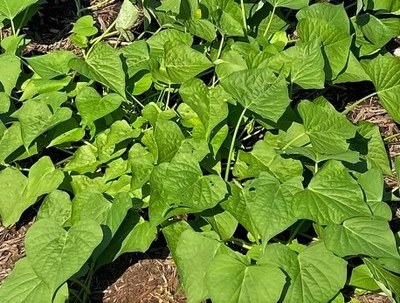
Cuphea
Three new cultivars of Cuphea were grown in the Trial Garden this year. All three were on the favorites list for the groundhog. They really did not get a chance to grow out and display their qualities as the animal damage was extensive. Blooms were not present until the last evaluation in mid-September. These Cuphea cultivars seemingly have a hardy root system in that they continued to push out new foliage after being cut to the ground numerous times.
The scores for the Cupheas reflect the growth of foliage and flowers that were observed toward the end of the season.
Cuphea ignea 'Blackberry Sparkler' (60%; 14 in. X 18 in.; tt)
A relatively new cultivar, Blackberry Sparkler was released to growers in 2020. It promised non-stop white blooms tipped in red and black. This Cuphea was snacked on throughout the summer, rarely showing a flower or gaining size until September. It never came close to the expected size. There were no flowers on the plants when the flower count took place. The flowers that were produced were very small and inconspicuous. By the last evaluation in mid-September, the plants were beginning to thrive and scored a 97% for that one evaluation period. There were numerous, dainty flowers on the plant, but they still were quite inconspicuous.

Photo Credit: PlantHaven International, planthaven.com
Cuphea hyssopifolia 'Funny Face' (63%; 8-12 in.; tt)
This is the same story as 'Blackberry Sparkler'. At the last evaluation of the season, the 'Funny Face' in the blossoms was visible and foliage covered stems earning this Cuphea a 100% for that one evaluation period. As with Blackberry Sparkler the flowers are small and delicate. It is a subtle plant; not a standout in our view.
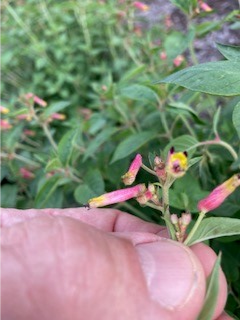
Cuphea hybrida 'Honeybells' (64%; 10-12 in. X 8-14 in.; tt)
'Honeybells' escaped the severe animal damage of the other two Cupheas but was not untouched. One plant displayed 40 blooms at the flower count. Considering the challenges with the groundhog, the mid-season short-lived recovery showed potential for this Cuphea in the garden. 'Honeybells' had a big comeback for the last evaluation with a 98.4% score. Like the other two Cupheas in our Trial Garden, the flowers on 'Honeybells' are small and dainty. 'Honeybells' delivered a much better performance at the Penn State flower trial in 2021 scoring an average of 4.97 out of 5! This Cuphea may be worth another try.


Photo Credit: Penn State University www.agsci.psu.edu
Calibrachoa hybrida 'Chameleon™ Blackberry Pie' (67%; 6-12 in. X 8-12 in.; tt)
This calibrachoa was a summer 2021 trial from the Westhoff flower breeding company. In their trials it showed "superior heat tolerance and exceptional flower stability" but it did not do well in the Trial Garden throughout the summer. The three plants started out with high ratings. By mid-July one plant was turning yellow, by mid-August two plants showed lots of browning, and by the end of August only one plant remained. Sixty blooms were on one plant at the early August count, but the flowers never displayed vibrant color or the variation expected. Calibrachoa is susceptible to root rot from excessive moisture; perhaps the weekly watering was too much love for Blackberry Pie.

Lavandula dentata - French Lavender (78%; 36 in. X 24 in.)
The new Lavender cultivars were not available in our local greenhouses so instead three French Lavender plants were selected. The foliage, as expected, was exceptionally lovely - with fringed green-gray fragrant leaves. You could not walk past the Trial Garden without stroking the foliage to release the scent. The lack of uniformity quickly developed, and they were very slow to produce blooms. Blooms began to develop in early August on one plant and by the end of the evaluation period blooms still only appeared on that one plant. By early November all three plants had a few blooms. The uniformity improved but there still was a noticeable difference in size. Perhaps the soil in the Trial Garden is too acidic for good performance from Lavender. A soil test has not been completed recently but given the performance of our annuals and the location of the garden, it is a safe bet that the soil is on acidic side. Described as a 'tender perennial', two of the plants were moved into our other garden beds to see if they would make it through the winter.
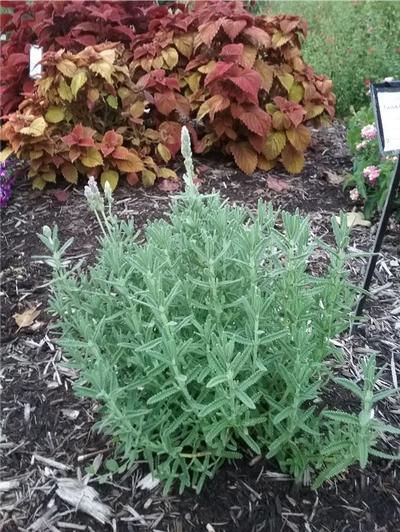
Dianthus chinensis 'Diana' series
Two color variations in the Dianthus 'Diana' series were chosen for this year's garden. Both started out well with a tight form and plentiful richly colored flowers, but both quickly began to decline. This may also have been 'too much love' as Dianthus is suspectable to root rot from excessive moisture. For the first half of the evaluation period, the plants had good uniformity and lovely flowers keeping the overall rating around the 50% mark. By the end of the evaluation period, they simply were unattractive. Both are small plants at 8 - 10 inches in height and width, and both required continual deadheading.
'Diana Blueberry' (78%; 8-10 in. X 9 in.)
About 25 flowers in early August

'Diana Lavender Picotee' (67%; 8-10 in. X 9 in.)
About 10 flowers in early August

Zinnia marylandica 'Zahara Starlight Rose' (84%; 12-18 in. X 12-18 in.)
In the past few years, Profusion Zinnias made quite a splash in the Trial Garden. This year 'Zahara Starlight Rose' was chosen. There were tons of flowers on these compact plants, but early in the season few showed the pink stripe giving this bicolor its name. As the season progressed, more and more of the flowers displayed the pink stripe on the petals but the bicolor was absent on enough blooms to cost this cultivar some points. This zinnia stayed in a nicely rounded mound reaching a bit over 14 inches with 80 blooms at the early August count. The foliage maintained good color throughout the season and showed no sign of disease. Overall, it made a lovely display but did not meet expectations as a bicolored flower.

Verbena x hortensis 'Vanessa™ Bicolor Purple' (87%; 6-10 in. X 15-18 in.)
This bicolored Verbena produced loads of clustered five petal blooms with white centers in clusters with two dark pink petals toward the inside of the cluster and three light purple petals toward the outside. It exceeded the specified width and displayed 45 blooms at the early August count. By late August the foliage was dying out in the center of the plant and continued to do so through September creating an overall unattractive presentation. As a result, the score dropped from 92% to 87%. The center dieback did not deter the pollinators from visiting.

Evolvulus glomeratus 'Beach Bum Blue' (89%; 6 in. X 12 in.)
These got off to a slow start - few blooms and the blooms were rather indistinct against the gray-green foliage. As the weather got warmer, they pushed out lots of medium blue blooms with delicate white centers on compact tightly branched plants. The plants present a round, low-to-the-ground plate-like shape. As evening nears, the blooms close until morning. These would be lovely spilling over a wall or pot. Overall, the plants were sized out at the middle of the 12-to-20-inch range and displayed about 75 blooms at the early August count.

Coleus
Three Coleus cultivars - Inferno, Stained Glassworks Kiwi Fern, and Vulcan - were in this year's garden. All were advertised to perform as well in sun as in shade. All three are relatively new on the market with Inferno and Vulcan being true trials. Inferno was released in 2016, Stained Glassworks Kiwi Fern in 2020, and Vulcan in 2022. They all stood up to the full sun conditions in the Trial Garden, but some fading of the color occurred on all three.
Coleus scutellarioides 'Inferno' (81%; 14-28 in. X 24-36 in.; tt)
Inferno, as the name suggests, has red-orange coloring with serrated foliage that is deeply textured. While these plants scored better early in season (judging the plant by what it is supposed to do), the late season look was appealing, perhaps more so than the consistent color early in the season. The variation in the color caused by the fading made a nice contrast against the mulch, whereas early in the season this Coleus seemed drab and blended too much into the mulch. Late in August, the flowers were pruned. By the mid-September evaluation, new growth was visible in the center of the plants. Inferno met the high end of the advertised size reaching about 28 inches high and 30 inches across.

Coleus scutellarioides 'Vulcan' (90%; 28 in. X 28 in.; tt)
This lovely foliage plant has deep, red-leaning, scalloped mahogany leaves with pink in the center rimmed in creamy lime green. Vulcan started with vibrant color, but one plant quickly began to fade. By early August this solid 100% rated performer dropped a notch, and by mid-September the fading was substantial. Using just the scores from the last two evaluations, the rating fell to 70%. The plants that were somewhat shaded by their neighbors retained better color. The plants in the Trial Garden easily reached the maximum size.
Note: Vulcan was in the 2021 Penn State flower trials grown in both sun and shade conditions and scored 94.2% and 95.8% respectively.

Coleus scutellarioides 'Stained Glassworks® Kiwi Fern' (93%; 12 in. X 12 in.)
The foliage on this Coleus has lovely, scalloped edges with a lime green rim. An attractive foliage plant by all accounts, perhaps better suited to part shade than full sun. This Coleus started with vibrant color, but one plant showed significant fading by mid-July. Throughout early August, Kiwi Fern was consistently rated at 100%, then the color began to fade dropping individual bimonthly scores to 70%. Like Vulcan, the plants that were somewhat shaded by their neighbors retained better color. The tag in these plants stated size as 12 X 12 inches but all online sources state the size of Kiwi Fern at 24 X 12 inches. By the end of the season the plants in our Trial Garden exceeded 24 X 24 inches.

Salvia
A trio of Salvia cultivars took center stage in the 2022 Trial Garden - one with red and white blooms, one with deep purple/black blooms, and one with deep reddish/purple blooms. The combination of color and leaf texture made an outstanding display. All three promised and delivered height measured in feet. Like most Salvia, this year's trio were magnets for bees and hummingbirds.
Salvia microphylla 'Hot Lips' (90%; 3-6 ft. X 18-24 in.)
'Hot Lips' is a North American native (Mexico) that may produce solid red, solid white, and bicolor red and white blossoms on a single plant atop tall, thin stems with fragrant, slightly scalloped leaves. This salvia grows to 3 to 6 feet in its native environment. Those in the Trial Garden topped out at little over 3 feet with an almost equal spread. The stems sway easily in the wind and in our garden drooped over their neighbors. Primarily covered in solid red flowers; the bicolor flowers appeared late in the summer. The flowers have a delicate shape, the solid color flowers are cute, but the bicolor flowers are much more attractive. Not a heavy bloomer in our garden, we counted 70 flowers in early August by which time it was hard to determine where one plant stopped and the next began. Given the size of the flowers on a 3 X 3-foot plant, the flowers look somewhat sparce, but it did bloom from the time it was planted through early November when the garden was cleaned-out. The spent flower stalks are quite unattractive so deadheading may be needed for a pleasing display.

Salvia guaranitica 'Black & Bloom' (91%; 36-48 in. X 36-48 in.)
With large, deeply textured, thick leaves and the deep purple petals protruding from the almost black calyx, 'Black & Bloom' makes quite a statement in the garden. Early in the season the blooms were sparse, but the texture of the leaves still made an attractive display. In early August two of the plants had been trampled such that only one plant was evaluated. By mid-August the two damaged plants made a great comeback and rejoined the evaluations. The healthiest plant bore about 25 eight-to-ten-inch flower spikes. The plants grew to about 36 X 36 inches which is at the low end of the size range. The stems seem quite brittle and snap easily at the base as the leaves and flowers stalks grew heavy.

Salvia guaranitica 'Rockin® Fuchsia' (99%; 24-36 in. X 18-24 in.)
This Salvia has gorgeous flowers on plants with the same deeply textured, thick leaves as 'Black & Bloom'. The flowers have fuchsia-colored petals escaping a burgundy calyx on tall stems. Our plants easily reached the 36 X 24 inch expected size and had 50 flowers elevated above the foliage on 8-10-inch stems. This Salvia scored solid 4's at all evaluations up through the middle of August when there was slip in the uniformity, some fading in the flowers, and a bit of tarnish on a few leaves. However, 'Rockin® Fuchsia' was still gorgeous in early November. Hummingbirds were frequently spotted at the flowers.

Crossandra infundibuliformis 'Orange Marmalade' (95%; 16-20 in. X 12 in.)
Crossandra was a solid performer in our garden for the entire season. From the shiny dark green foliage to the creamsicle orange tropical looking flowers, this plant delighted us all summer long. The height stayed a bit shorter than expected but the blooms just kept coming - 15 blooms on one plant at the count. As an added attraction, the seeds pods form along the stem which resembles a stalk of wheat as the flowers continue to push out from the top of the stem. Orange Marmalade is noted for its high pest and disease resistance. Even the groundhog left it alone! Initially, one of the plants trailed the others in size causing it to lose some points in the uniformity category. It caught up but continued to lag a bit; otherwise, these plants would have achieved a 100% with the outstanding flower and color.

Catharanthus roseus - Vinca
Additional colors have been added to the Tattoo™ Vinca series since their first introduction. We decided to try three different colors of this annual vinca noted for their large, bicolored flowers where the color variation almost appears to be air-brushed. Always a butterfly magnet and solid performer in varied conditions, we were not disappointed by their performance. Tattoo is noted to display the best color contrast in warm conditions. These vinca easily stood up to last year's high temperatures.

Catharanthus roseus 'Tattoo™ Blueberry' Vinca (98%; 10-14 in.)
The Blueberry color Vinca Tattoo produced dozens of deep purple/blue blooms many with significant areas of light streaking. The overall presentation made an outstanding display of purple, blue, and white streaked flowers on huge plants with more than 70 blooms during the early August count. Note: 'Tattoo™ Blueberry' scored 89% in 2020 Trial & Idea Garden trials.
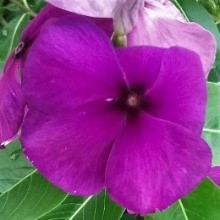
Catharanthus roseus 'Tattoo™ Raspberry' Vinca (100%; 10-14 in.)
What more can be said about a plant with a perfect score. This Vinca wowed us all year. The color is dazzling, and the contrast just makes it more outstanding. 'Tattoo™ Raspberry' Vinca exceeded the size estimates of 10 X 14 inches and displayed 60+ blooms on one plant. This was a solid performer all year in the garden.

Catharanthus roseus 'Tattoo™ Tangerine' Vinca (90%; 10-14 in.)
While still a lovely flower, Tattoo™ Tangerine was less impressive than the Blueberry or Raspberry cultivars. The flowers displayed a delicate light rim on the petals with a dainty white star in the center surrounded by a deeper pink-purple center. Even with this, somehow the color and varation was not as stricking. It did exceed the size expectations but did not get as big as the other two Vincas trialed this year. Bloom count came in at about 50 blooms.

Petunia x hybrida 'Bees Knees' (97%; 8-10 in. X 16-22 in.; tt)
If you are a petunia fan, or even if you are not, put this petunia on your list - it is an all-around winner. Released in 2021, this is the first petunia to win a gold metal distinction in the All-America Selections (AAS) awards since 1950! And it received the Greenhouse Grower's Medal of Excellence Reader's Choice in 2020. It started out full of eye-catching yellow blooms with darker yellow center and just a hint of green along the veins. And it just kept pushing out blooms all season with no deadheading. There was some minor insect damage on the flowers. Three of the plants exceeded the expected spread and boasted 120 blooms on one plant at the early August count. We ended evaluation in mid-September this year since most of the plants were well past their prime. But, in early November at fall clean-up after a few light frosts, this petunia was still pumping out lots of blooms. It was painful to have to pull them out. Where this plant lost some points was in the uniformity category - two of the five plants were a bit smaller than the other three. This petunia would be sensational in a hanging basket or pot.
Note: Bees Knees rated 95%, or 4.75 out of 5, in the 2020 Penn State flower trials at the Southeast Agricultural Research and Extension Center (SEAREC) in Lancaster County.


Lantana 'Heartland Neon' (99%; 12-24 in. X 24-32 in.; tt)
Even the pictures could not describe just how beautiful the blooms were on this lantana or how bright the colors looked on a sunny day. The blooms begin yellow then transform through orange and red to shades of purple without losing the sheen of newly opened flowers, and they just keep coming all summer long. One plant was slow to produce blooms causing it to lose points for the grouping early in the evaluation cycle but quickly all three plants were covered in multiple colors of bloom and multiple-colored blooms - 150 on one plant at the early August count. These plants got solid 4's across the board after the first evaluation. This Lantana easily exceed the size prediction of 24 X 32 inches while retained a stiff, upright, mounded shape with blooms the whole way to the ground and was still going strong in early November after several light frosts.

Lantana camara 'Landscape® Bandana Pink' Spreading Lantana
(100%; 16-20 in. X 32-36 in.; tt)
In recent years, at least one lantana has been planted in the Trial Garden. This year was a first for a spreading lantana - and oh, did it spread. We had to rescue a couple of zinnia plants from being completely covered about mid-August. Our three plants far exceeded the 36-inch spread predicted, and one plant produced over 400 flower clusters. The flower cluster starts out pink then the center turns a lovely yellow as the flower ages. This is another case where a picture was unable to capture the true beauty of the flowers. Landscape Bandana Pink is a true winner - solid 4 ratings across the board all summer, dense sprawling branches covered in blooms from May through November. It stood up to the light frosts in October and on November 5th still created an awesome display of color.

In addition to the 'true trial' plants in the garden this year, the committee was faced with a few other trials. The start of the gardening season was delayed due to the transfer of property ownership to Allaire Health Services until completion of the agreement for the Master Gardeners to continue to maintain the Trial and Idea Garden. It was a dreadfully hot summer with little precipitation resulting in dry soil and no escape from the sun. And then there was the groundhog and the voles.
In the face of this adversity, some plants showed real star power for central PA gardens. The two Lantanas - 'Landscape® Bandana Pink' and 'Heartland Neon' - coming in at 100% and 99% respectively - were sensational. Every garden should give them a try. Be sure to give them enough room, especially 'Landscape® Bandana Pink'. 'Bees Knees' Petunia is a straight up winner - lovely color variations with a beautiful sunny look and they do not need to be deadheaded to continue to bloom all summer long. Vinca is always a solid performer and a real magnet for pollinations and butterflies; the colors in the Tattoo™ series are a must try. Let's not overlook the tropical charm of 'Orange Marmalade' Crossandra. And of course, the Rockin® Fuchsia was a real showstopper and a hummingbird favorite. While we did not have great success with this year's Cuphea plants, they might be attractive in a hanging basket (and out of reach of any neighborhood groundhogs) where the dainty flowers can be observed up close. The 'Solarscape Salmon' has real potential. It handled the full sun and very hot conditions before our groundhog feasted on it. An Impatiens that handles full sun is worth a try.
Happily brought to you by the Trial and Idea Garden Committee!
Content courtesy of the Penn State Master Gardeners of Cumberland County Trial and Idea Garden Committee members
Photo Credit: Penn State Extension Master Gardeners Janey Gunn, Bob Powell, Pam Wenner, and Jay Crist except where noted.

